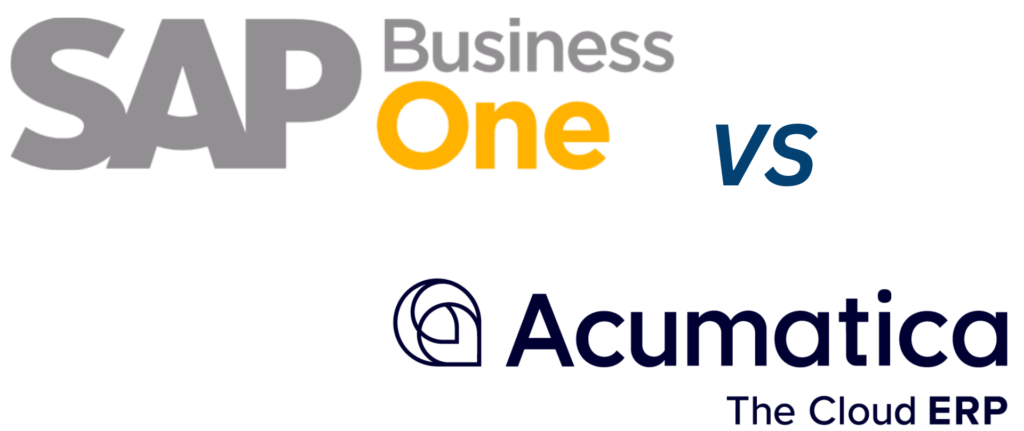SAP Business One vs. Acumatica: A Scalability Showdown

SAP Business One vs. Acumatica: A Scalability Showdown
Scalability is a crucial factor when selecting an ERP system. SAP Business One and Acumatica both offer scalable solutions, but which one truly supports your business as it grows? In this detailed comparison, we’ll explore the scalability features of SAP Business One and Acumatica, helping you choose the right ERP system for your business needs.
Understanding Scalability in ERP Systems
Scalability is the ERP system’s ability to handle growth in terms of data volume, users, and transactions without sacrificing performance. For companies using SAP Business One, the ability to scale efficiently is essential for adapting to changing demands. This comparison also looks at how Acumatica tackles these scalability challenges.
In ERP systems, scalability is often divided into two types:
- Vertical Scalability: This refers to scaling up by increasing server capacity (CPU, memory, storage) to support higher workloads. SAP Business One is known for its excellent vertical scalability, especially for small to medium-sized businesses.
- Horizontal Scalability: Also known as scaling out, this involves adding additional servers to distribute workloads. Larger companies often prefer horizontal scalability, which is effectively supported by SAP Business One and Acumatica.
Scalability Features of SAP Business One
SAP Business One offers robust scalability options to support growing businesses. Here’s a breakdown of its key scalability features:
1. Vertical Scalability in SAP Business One
SAP Business One allows businesses to increase server capacity as needed. Companies can add more memory, CPU power, and storage to a single server, ensuring that SAP Business One can handle the growing number of users and transactions without compromising performance.
2. Horizontal Scalability
While SAP Business One excels in vertical scaling, it also supports horizontal scalability. This means you can distribute the workload across multiple servers, ensuring that SAP Business One remains responsive even during peak usage periods.
3. High Availability and Failover Clustering
SAP Business One ensures system availability with features like failover clustering and load balancing. Businesses using SAP Business One benefit from minimal downtime, ensuring that operations continue smoothly even during system failures.
The combination of vertical and horizontal scalability makes SAP Business One ideal for businesses that expect growth, whether gradual or rapid.
Scalability Features of Acumatica
While SAP Business One offers robust scalability, Acumatica provides unique advantages thanks to its cloud-based infrastructure.
1. Cloud-Based Architecture
Acumatica is built on a cloud-based platform, allowing businesses to scale their resources seamlessly. Unlike SAP Business One, which relies on physical infrastructure for scaling, Acumatica allows businesses to scale up or down based on demand, offering flexibility without requiring significant investments in hardware.
2. Elastic Scalability
Acumatica takes full advantage of the cloud’s elasticity. This means that as demand increases, Acumatica dynamically allocates additional resources to maintain performance. This feature allows Acumatica to scale effortlessly, which is particularly useful for businesses experiencing rapid growth.
3. Multi-Tenant Architecture
Acumatica’s multi-tenant architecture allows businesses to share resources efficiently, which further enhances scalability. This feature helps businesses using Acumatica scale operations without performance bottlenecks, making Acumatica ideal for companies with rapidly changing demands.
Final Verdict: SAP Business One vs. Acumatica Scalability
Choosing between SAP Business One and Acumatica depends on your business’s scalability needs. Both systems offer scalable solutions, but the method of scaling differs:
- SAP Business One: Offers excellent vertical scalability and robust horizontal scalability through its flexible infrastructure. It’s perfect for businesses that need on-premise control and are looking to gradually increase server capacity.
- Acumatica: With its cloud-based architecture and elastic scalability, Acumatica is the ideal solution for businesses looking for flexible, cloud-native scalability without upfront hardware costs.
Want to learn more about how SAP Business One can support your business growth? Visit our SAP Business One implementation page.
When deciding between SAP Business One and Acumatica, it’s essential to consider your company’s growth projections, IT infrastructure, and scalability requirements. Both ERP systems offer strong scalability options, but the right choice depends on your unique needs.
For more insights into Acumatica’s cloud scalability, check out the official Acumatica Cloud ERP page.
Conclusion
Both SAP Business One and Acumatica offer excellent scalability options. If your business is looking for cloud-based flexibility, Acumatica is the better fit. However, for businesses that prefer on-premise control with powerful vertical scalability, SAP Business One is a strong contender. Make sure to evaluate your company’s current and future scalability needs before making your decision.
Ready to scale your business with the right ERP system? Whether you’re considering SAP Business One or Acumatica, our team can help you choose the perfect solution tailored to your growth needs. Contact us today for a free consultation and discover how to future-proof your operations with the best ERP system.






